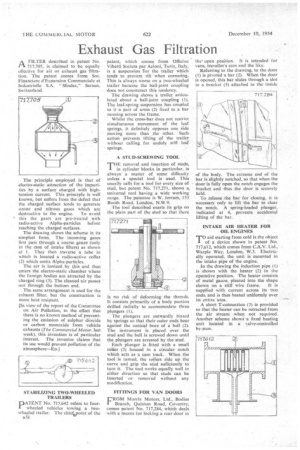Exhaust Gas Filtration
Page 72

If you've noticed an error in this article please click here to report it so we can fix it.
A FILTER described in patent No.
717,705, is claimed to be equally effective for air or exhaust gas filtration. The patent comes from Soc. Financiere d'Expansion Commerciale et IndustrieIle S.A. " Sfindex," Sarnen. Switzerland.
The principle employed is that of electro-static attraction of the impurities by a surface charged with hightension current This principle is well known, but suffers from the defect that the charged surface tends to generate ozone and nitrous gases which are destructive to the engine. To avoid this the gases are pre-treated with radio-active Alpha-particles before reaching the charged surfaces.
The drawing shows the scheme in its simplest form. The incoming gases first pass through a coarse gauze (only in the Case of intake filters) as shown at 1. They then traverse a tube in which is located a radio-active collar (2) which emits Alpha-particles.
The air is ionized by this and then enters the electro-sta tic chamber where the foreign bodies are attracted by the charged ring (3). The cleaned air passes out through the bottom end.
The same arrangement is used for the exhaust filter, but the construction is more heat resistant.
[In view of the report of the Committee on Air Pollution, to the effect that there is no known method of preventing the emission of sulphur dioxide or carbon monoxide from vehicle exhausts (The Commercial Motor, last week), this invention is of particular interest. The inventor claims that its use would prevent pollution of the atmosphere—Ea.] STARILIZING TWO-WHEELED TRAILERS
DATENT No. 715,642 refers to fourwheeled vehicles towing a twowheeled trailer. The chieVoint of the n38 patent, which comes from Officine Viberti Societa par Azioni, Turin, Italy, is a suspension for the trailer which tends to prevent tilt when cornering. This is always worse on a two-wheeled trailer because the ball-joint coupling does not counteract this tendency.
The drawing shows a trailer articulated about a ball-joint coupling (I). The leaf-spring suspension has coupled to it a pair of arms (2) fixed to a bar running across the frame.
Whilst the cross-bar does not restrict simultaneous movement of the leaf springs, it definitely opposes one side moving more than the other. Such action prevents tilting of the trailer without calling for unduly stiff leaf springs.
A STUD-SCREWING TOOL
THE removal and insertion of studs, in cylinder blocks in particular, is always.' a matter of some difficulty unless a special tool is used. This usually calls for a tool for every size of stud, but patent No. 717.271, shows a, universal tool having a wide working range. The patentee is W. Jerrarn, 153 Booth Road. London, N.W.9.
The tool described exerts its grip on the plain part of the stud so that there is no risk of deforming" the threads. It consists primarily of a body portion drilled radially to accommodate three plungers (1).
The . plungers are outwardly biased by springs so that their outer ends bear against the conical bore of a -bell (2). The instrument is placed over the stud and the bell is screwed down until the plungers are arrested by the stud.
Each plunger is fitted with a small roller (3) housed in a circular notch which acts as a cam track. When the tool is turned, the rollers ride up the curve and grip the stud sufficiently to turn it. The tool works equally well in either direction so that studs can be inserted or removed without any modification.
FITTINGS FOR VAN DOORS L'ROM Morris Motors, Ltd., Bodies I Branch, Quinton Road, Coventry, comes patent No. 717,284, which deals with a means for locking a rear door in the' open position. It is intended for vans, traveller's cars and the like.
Referring to the (hawing, to the door (1) is pivoted a bar (2). When the door is opened, this bar slides through a slot in a bracket (3) attached to the inside of the body. The extreme end of the bar is slightly notched, so that when the door is fully open the notch engages the bracket and thus the door is securely held.
To release the bar for closing, it is necessary only to lift the bar to clear the notch. A spring-loaded plunger, indicated at 4, prevents accidental lifting of the bar.
INTAKE AIR HEATER FOR OIL ENGINES TO aid starting from cold is the object I of a device shown in patent No. 717,612, which comes from C.A.V. Ltd., Warple Way, London, W.3. Electrically operated, the unit is mounted in the intake pipe of the engine.
In the drawing the induction pipe ( t) is shown with the heater (2) in the operative position. The heater consists of metal gauze, pleated into the shape shown on a stiff wire frame. It is supplied with current across its two ends, and is thus heated uniformly over its entire area.
A short T-cohnectiort (3) is provided so that the heater can be retracted from the air stream when not required. Another scheme shows a fixed heating unit located in a valve-controlled by-pass.




















































































































